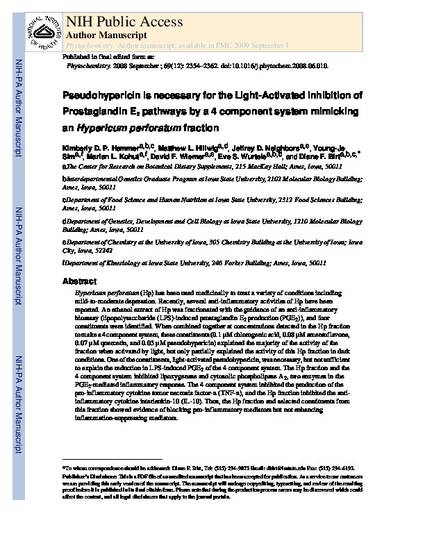
Hypericum perforatum (Hp) has been used medicinally to treat a variety of conditions including mild-to-moderate depression. Recently, several anti-inflammatory activities of Hp have been reported. An ethanol extract of Hp was fractionated with the guidance of an anti-inflammatory bioassay (lipopolysaccharide (LPS)-induced prostaglandin E2 production (PGE2)), and four constituents were identified. When combined together at concentrations detected in the Hp fraction to make a 4 component system, these constituents (0.1 μM chlorogenic acid, 0.08 μM amentoflavone, 0.07 μM quercetin, and 0.03 μM pseudohypericin) explained the majority of the activity of the fraction when activated by light, but only partially explained the activity of this Hp fraction in dark conditions. One of the constituents, light-activated pseudohypericin, was necessary, but not sufficient to explain the reduction in LPS-induced PGE2 of the 4 component system. The Hp fraction and the 4 component system inhibited lipoxygenase and cytosolic phospholipase A2, two enzymes in the PGE2-mediated inflammatory response. The 4 component system inhibited the production of the pro-inflammatory cytokine tumor necrosis factor-α (TNF-α), and the Hp fraction inhibited the antiinflammatory cytokine interleukin-10 (IL-10). Thus, the Hp fraction and selected constituents from this fraction showed evidence of blocking pro-inflammatory mediators but not enhancing inflammation-suppressing mediators. *
Available at: http://works.bepress.com/diane_birt/18/

This is a manuscript of an article from Phytochemistry 69 (2008): 2354, doi: 10.1016/j.phytochem.2008.06.010. Posted with permission.